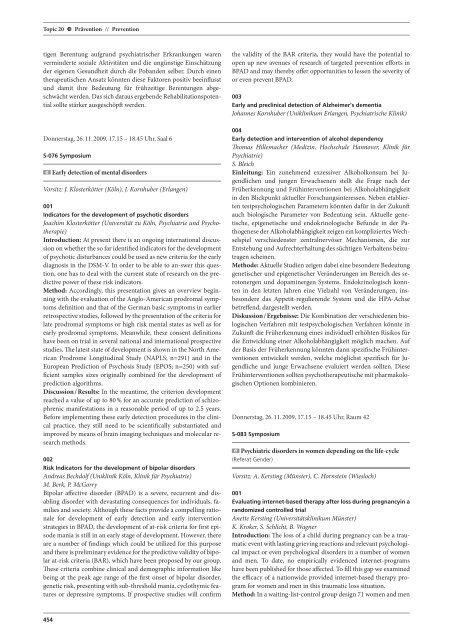Psychische Erkrankungen in der Lebensspanne ... - DGPPN
Psychische Erkrankungen in der Lebensspanne ... - DGPPN
Psychische Erkrankungen in der Lebensspanne ... - DGPPN
Erfolgreiche ePaper selbst erstellen
Machen Sie aus Ihren PDF Publikationen ein blätterbares Flipbook mit unserer einzigartigen Google optimierten e-Paper Software.
Topic 20 G Prävention // Prevention<br />
tigen Berentung aufgrund psychiatrischer <strong>Erkrankungen</strong> waren<br />
verm<strong>in</strong><strong>der</strong>te soziale Aktivitäten und die ungünstige E<strong>in</strong>schätzung<br />
<strong>der</strong> eigenen Gesundheit durch die Pobanden selber. Durch e<strong>in</strong>en<br />
therapeutischen Ansatz könnten diese Faktoren positiv bee<strong>in</strong>flusst<br />
und damit ihre Bedeutung für frühzeitige Berentungen abgeschwächt<br />
werden. Das sich daraus ergebende Rehabilitationspotential<br />
sollte stärker ausgeschöpft werden.<br />
Donnerstag, 26. 11. 2009, 17.15 – 18.45 Uhr, Saal 6<br />
S-076 Symposium<br />
454<br />
Early detection of mental disor<strong>der</strong>s<br />
Vorsitz: J. Klosterkötter (Köln), J. Kornhuber (Erlangen)<br />
001<br />
Indicators for the development of psychotic disor<strong>der</strong>s<br />
Joachim Klosterkötter (Universität zu Köln, Psychiatrie und Psychotherapie)<br />
Introduction: At present there is an ongo<strong>in</strong>g <strong>in</strong>ternational discussion<br />
on whether the so far identified <strong>in</strong>dicators for the development<br />
of psychotic disturbances could be used as new criteria for the early<br />
diagnosis <strong>in</strong> the DSM-V. In or<strong>der</strong> to be able to an-swer this question,<br />
one has to deal with the current state of research on the predictive<br />
power of these risk <strong>in</strong>dicators.<br />
Method: Accord<strong>in</strong>gly, this presentation gives an overview beg<strong>in</strong>n<strong>in</strong>g<br />
with the evaluation of the Anglo-American prodromal symptoms<br />
def<strong>in</strong>ition and that of the German basic symptoms <strong>in</strong> earlier<br />
retrospective studies, followed by the presentation of the criteria for<br />
late prodromal symptoms or high risk mental states as well as for<br />
early prodromal symptoms. Meanwhile, these consent def<strong>in</strong>itions<br />
have been on trial <strong>in</strong> several national and <strong>in</strong>ternational prospective<br />
studies. The latest state of development is shown <strong>in</strong> the North American<br />
Prodrome Longitud<strong>in</strong>al Study (NAPLS; n=291) and <strong>in</strong> the<br />
European Prediction of Psychosis Study (EPOS; n=250) with sufficient<br />
samples sizes orig<strong>in</strong>ally comb<strong>in</strong>ed for the development of<br />
prediction algorithms.<br />
Discussion / Results: In the meantime, the criterion development<br />
reached a value of up to 80 % for an accurate prediction of schizophrenic<br />
manifestations <strong>in</strong> a reasonable period of up to 2.5 years.<br />
Before implement<strong>in</strong>g these early detection procedures <strong>in</strong> the cl<strong>in</strong>ical<br />
practice, they still need to be scientifically substantiated and<br />
improved by means of bra<strong>in</strong> imag<strong>in</strong>g techniques and molecular research<br />
methods.<br />
002<br />
Risk Indicators for the development of bipolar disor<strong>der</strong>s<br />
Andreas Bechdolf (Unikl<strong>in</strong>ik Köln, Kl<strong>in</strong>ik für Psychiatrie)<br />
M. Berk, P. McGorry<br />
Bipolar affective disor<strong>der</strong> (BPAD) is a severe, recurrent and disabl<strong>in</strong>g<br />
disor<strong>der</strong> with devastat<strong>in</strong>g consequences for <strong>in</strong>dividuals, families<br />
and society. Although these facts provide a compell<strong>in</strong>g rationale<br />
for development of early detection and early <strong>in</strong>tervention<br />
strategies <strong>in</strong> BPAD, the development of at-risk criteria for first episode<br />
mania is still <strong>in</strong> an early stage of development. However, there<br />
are a number of f<strong>in</strong>d<strong>in</strong>gs which could be utilized for this purpose<br />
and there is prelim<strong>in</strong>ary evidence for the predictive validity of bipolar<br />
at-risk criteria (BAR), which have been proposed by our group.<br />
These criteria comb<strong>in</strong>e cl<strong>in</strong>ical and demographic <strong>in</strong>formation like<br />
be<strong>in</strong>g at the peak age range of the first onset of bipolar disor<strong>der</strong>,<br />
genetic risk, present<strong>in</strong>g with sub-threshold mania, cyclothymic features<br />
or depressive symptoms. If prospective studies will confirm<br />
the validity of the BAR criteria, they would have the potential to<br />
open up new avenues of research of targeted prevention efforts <strong>in</strong><br />
BPAD and may thereby offer opportunities to lessen the severity of<br />
or even prevent BPAD.<br />
003<br />
Early and precl<strong>in</strong>ical detection of Alzheimer‘s dementia<br />
Johannes Kornhuber (Unikl<strong>in</strong>ikum Erlangen, Psychiatrische Kl<strong>in</strong>ik)<br />
004<br />
Early detection and <strong>in</strong>tervention of alcohol dependency<br />
Thomas Hillemacher (Mediz<strong>in</strong>. Hochschule Hannover, Kl<strong>in</strong>ik für<br />
Psychiatrie)<br />
S. Bleich<br />
E<strong>in</strong>leitung: E<strong>in</strong> zunehmend exzessiver Alkoholkonsum bei Jugendlichen<br />
und jungen Erwachsenen stellt die Frage nach <strong>der</strong><br />
Früherkennung und Früh<strong>in</strong>terventionen bei Alkoholabhängigkeit<br />
<strong>in</strong> den Blickpunkt aktueller Forschungs<strong>in</strong>teressen. Neben etablierten<br />
testpsychologischen Parametern könnten dafür <strong>in</strong> <strong>der</strong> Zukunft<br />
auch biologische Parameter von Bedeutung se<strong>in</strong>. Aktuelle genetische,<br />
epigenetische und endokr<strong>in</strong>ologische Befunde <strong>in</strong> <strong>der</strong> Pathogenese<br />
<strong>der</strong> Alkoholabhängigkeit zeigen e<strong>in</strong> kompliziertes Wechselspiel<br />
verschiedenster zentralnervöser Mechanismen, die zur<br />
Entstehung und Aufrechterhaltung des süchtigen Verhaltens beizutragen<br />
sche<strong>in</strong>en.<br />
Methode: Aktuelle Studien zeigen dabei e<strong>in</strong>e beson<strong>der</strong>e Bedeutung<br />
genetischer und epigenetischer Verän<strong>der</strong>ungen im Bereich des serotonergen<br />
und dopam<strong>in</strong>ergen Systems. Endokr<strong>in</strong>ologisch konnten<br />
<strong>in</strong> den letzten Jahren e<strong>in</strong>e Vielzahl von Verän<strong>der</strong>ungen, <strong>in</strong>sbeson<strong>der</strong>e<br />
das Appetit-regulierende System und die HPA-Achse<br />
betreffend, dargestellt werden.<br />
Diskussion / Ergebnisse: Die Komb<strong>in</strong>ation <strong>der</strong> verschiedenen biologischen<br />
Verfahren mit testpsychologischen Verfahren könnte <strong>in</strong><br />
Zukunft die Früherkennung e<strong>in</strong>es <strong>in</strong>dividuell erhöhten Risikos für<br />
die Entwicklung e<strong>in</strong>er Alkoholabhängigkeit möglich machen. Auf<br />
<strong>der</strong> Basis <strong>der</strong> Früherkennung könnten dann spezifische Früh<strong>in</strong>terventionen<br />
entwickelt werden, welche möglichst spezifisch für Jugendliche<br />
und junge Erwachsene evaluiert werden sollten. Diese<br />
Früh<strong>in</strong>terventionen sollten psychotherapeutische mit pharmakologischen<br />
Optionen komb<strong>in</strong>ieren.<br />
Donnerstag, 26. 11. 2009, 17.15 – 18.45 Uhr, Raum 42<br />
S-083 Symposium<br />
Psychiatric disor<strong>der</strong>s <strong>in</strong> women depend<strong>in</strong>g on the life-cycle<br />
(Referat Gen<strong>der</strong>)<br />
Vorsitz: A. Kerst<strong>in</strong>g (Münster), C. Hornste<strong>in</strong> (Wiesloch)<br />
001<br />
Evaluat<strong>in</strong>g <strong>in</strong>ternet-based therapy after loss dur<strong>in</strong>g pregnancy<strong>in</strong> a<br />
randomized controlled trial<br />
Anette Kerst<strong>in</strong>g (Universitätskl<strong>in</strong>ikum Münster)<br />
K. Kroker, S. Schlicht, B. Wagner<br />
Introduction: The loss of a child dur<strong>in</strong>g pregnancy can be a traumatic<br />
event with last<strong>in</strong>g griev<strong>in</strong>g reactions and relevant psychological<br />
impact or even psychological disor<strong>der</strong>s <strong>in</strong> a number of women<br />
and men. To date, no empirically evidenced <strong>in</strong>ternet-programs<br />
have been published for those affected. To fill this gap we exam<strong>in</strong>ed<br />
the efficacy of a nationwide provided <strong>in</strong>ternet-based therapy program<br />
for women and men <strong>in</strong> this traumatic loss situation.<br />
Method: In a wait<strong>in</strong>g-list-control group design 71 women and men


